
It is not uncommon to hear or read the statement that no British film is complete without at least one ‘pub scene’, for the most part this may well appear true. The ‘pub’, short for public house is an establishment licensed to sell alcoholic drinks, a relaxed, social environment and a prominent part of British culture, the 17th century diarist Samuel Pepys referring to them as ‘the heart of England’.
In cinematic terms the pub often blurs with the Inn (a place where one can also seek lodging), the Tavern and even the Working Man’s Club or Bar. This list seeks to explore some notable pub related scenes and sequences within British film, examining their representation, their social and their cultural significance. Here are 10 noteworthy depictions of the pub within British film:
1. Withnail & I (1987) – Gender is a Fluid Concept
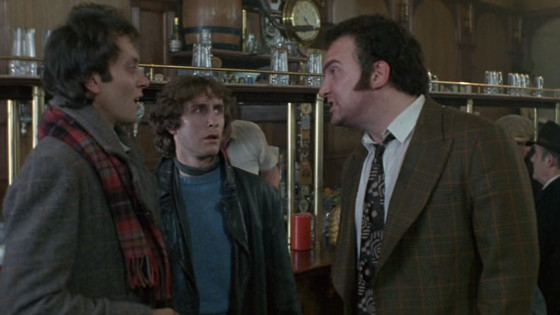
Bruce Robinson’s cult film set in 1969 about two out of work actors who go on holiday ‘by mistake’ features pub scenes in both town and country. Desperate to escape the tedium of their everyday lives and clear their heads, Withnail (Richard E. Grant) and ‘I’ (scripted as Marwood) (Paul McGann) venture into a local pub, The Mother Black Cap.
Unfortunately, Withnail has previously vomited on Marwood’s boots. Consequentially Marwood has been forced to scrub said boots with heavily fragranced ‘toilet water’, their freshly perfumed scent arousing aggression from a man (Daragh O’Malley – better recognised as Harper from the Sharpe TV series) sitting near the entrance to the toilets who bellows ‘ponce’ as McGann’s character passes by.
The result is a journey into the paranoid anxieties of Marwood’s mind as he tries to understand this reaction (the words ‘Fuck Arses’ carved into the toilet wall only complicating this), escalating into Withnail’s cowardly and comedic attempts to talk themselves (his own self) out of trouble. Here we see the pub as a stereotypically masculine environment, something the ‘feminine’ scent of Marwood’s boots have ‘contradicted’ – possibly even challenged.
At Withnail’s initial retort O’Malley’s character rises from his seat, erecting his frame to full proportion so that he appears as a hulking mass of testosterone looming toward them. There is no room for ‘feminine attributes’ such as discussion or explanation here, a challenge has been made and raw aggression is the accepted (masculine) solution, physical violence is imminent.
Robinson’s film can be understood as exploring characters ‘out of time’, both Withnail and Marwood are in a limbo world, circumstances making them outsiders wherever they go (as they are later in the when visiting The Crow and Crown pub – its drunken landlord another character ‘out of time’). The pub-related lesson here is stand out from the crowd at your peril and if you do – accept the unspoken rules or prepare for consequences – each pub has its own ‘rules’.
The Mother Black Cap, located in the Westbourne Green area of London was at the time of filming called The Frog and Firkin, its name changed to The Mother Black Cap in the wake if the film, it has now been demolished. The interiors of The Crown and Crown were not in Penrith at all but shot at Stocker’s Farm in Hertfordshire (a popular filming location). The other pub featured is The King Henry, in reality The Crown, located in Milton Keynes.
2. Passport to Pimlico (1949) – ‘Knees Up Mother Brown’
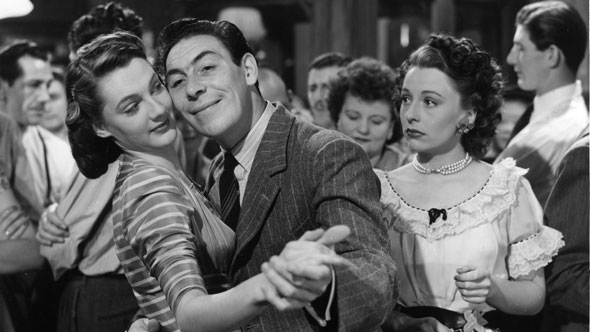
The pub can be a place to kick-back from (and at) the stresses and strains of the day and life in general – seldom more so than in this 1949 Ealing comedy, scripted by T.E.B Clarke.
A group of London residents in Pimlico discover that they are no longer under British rule and as a result post-war rationing no longer applies to them. The result of this is rebellion and a gleeful disregard for authority, seldom less prominent than in a raucous pub sequence in which the community unite in a chorus of ‘Knees Up Mother Brown’. Here, the community drinks, sings (Carry On regular Charles Hawtrey on piano) and laughs at their perceived good fortune; social boundaries are dropped and there is even some flirtatious behaviour.
Eventually the local policeman, an authority figure, enters and warns them it is past closing time – they point out closing time no longer applies, to which he lightens and joins in on the revelries. The mood only stalls slightly when the Police Sergeant (Michael Hordern) enters and is unrelenting in his maintenance of authority to which the residents inform him ‘nothing you can do about it cock’, tear up their ration books (something which would strike a chord with UK audiences at the time) and launch into a defiant rendition of Knees Up Mother Brown.
The origins of this song are sketchy, it was first published in 1938 but is likely much older with accounts of it being sung on armistice night in 1918, importantly for its use in the film, it carries associations with the British working class, in particular Cockneys.
This scene therefore can be viewed as portraying the local pub as the refuge of the ‘everyday people’ a place where they can forget their troubles (engage in a jolly ‘knees up’) and at least posture as flouting ‘higher authority’. Posture, in this case, for as the scene comes to a close, the camera follows the Sergeant out of the door, lingering on the entrance as if to foreshadow later events by saying ‘no good will come of this’ as both sound and image fade into the next scene.
As academic John Ellis observed, for all Ealing films’ popularity as films of the people, examples like Pimlico, The Lavender Hill Mob (1951),The Lady Killers (1955) and of particular relevance here Whiskey Galore (1949) (released as Tight Little Island in the U.S) frequently flirt with notions of rebellious and/or illegal behaviour (perhaps allowing post-war audiences a place to vent/visualise their frustrations as the long road to economic-recovery ahead aired); the company were at heart quite conservative and as a result such behaviour never quite pays off or is rewarded in the end.
Here the pub is portrayed as a hub at the heart of the community, a place where all gather, by and large united in their outlooks, a place where one can at least vent their frustrations to other similar minded folk, perhaps by having a ‘knees up’.
3. An American Werewolf in London (1981) – Culture Clash
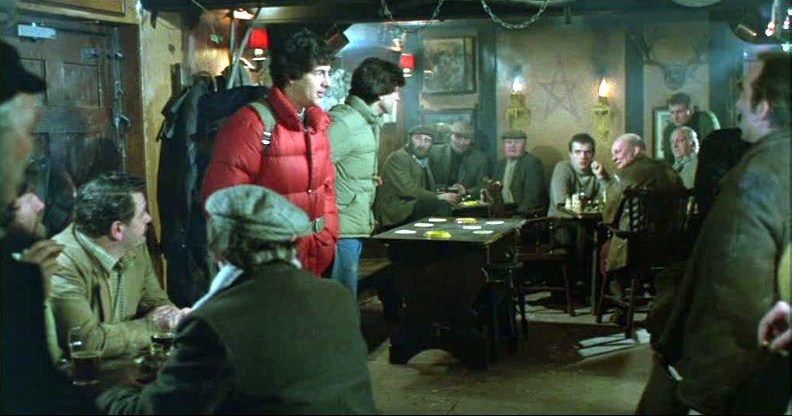
Writer/Director John Landis’ UK/US co-production sees one of the more frequently referenced ‘strangers entering the local pub’ scenes in film. David Kessler (David Naughton) and Jack Goodman (Griffin Dunne) are two American backpackers holidaying in England.
Whilst hiking across the North Yorkshire Moors they stop off at a remote inn, The Slaughtered Lamb. Here they encounter a variety of local characters (played by a wealth of British actors/comedians including Brian Glover and Rik Mayall). The two travellers in their synthetic puffer jackets and blue jeans are a contrast to the locals in their varying shades of beige and brown organic fibres blending in with the colour and decor of the inn, their dark pints of ale and their chess pieces.
The room falls silent as the pair enter, men in tweed caps huddle into corners, looking sideways at them, until one rowdy local (Glover) picks up on their U.S nationality along with a confused reference to the Alamo and begins to tell a joke, all laugh, the tension is momentarily broken. However, the travellers can’t help but ask about the pentagram scratched on the wall – a man misses a dart board and despite warnings, the pair decide they must leave.
The scene here is consciously making lightly comedic references to countless other similar depictions of the corresponding situations throughout cinema both in the world of horror and outside it, Lon Chaney and Universal horror are mentioned within the scene but the ‘stranger entering the crowded saloon bar’ is a parallel with Western film convention.
This is post-modern horror, made for an audience aware of the cinematic conventions, an audience who will both scoff and delight at the cliché. The sequence also represents many a real anxiety about entering a strange ‘local pub’, will one be instantly recognised as a stranger, what are the ‘unspoken rules’ here – something the pair in the film appear unaware of.
Adopting a Folk Horror perspective, one might say this is represents an encounter or clash with the cryptic ritualistic customs of isolated rurality – causing a man (David Schofield) to miss a dart board for the first time is surely a break from the accepted custom, an ill omen, however comedic. Although at the time, constructed in reference to other films and anecdotes relating genuine ‘holiday incidents’, the scene itself has now become something of a popular culture cornerstone for referencing similar encounters in reality and in turn perpetuating the cliché it took inspiration from.
Despite various stories over the years regarding where the inn was located, it was actually filmed nowhere near the North Yorkshire Moors, but in Wales, at a cottage in Crickadarn for the exterior scenes with the interior scenes shot at The Black Swan in Martyrs Green, Surrey.
4. The Wickerman (1973) – When to Embrace or Decline Local Customs?
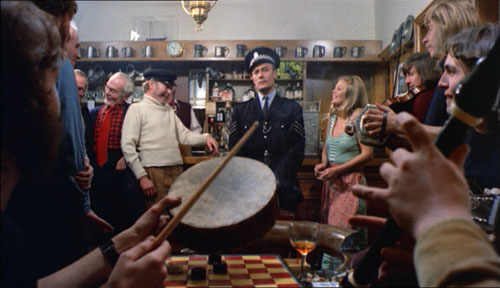
Following on in this list from American Werewolf, Robin Hardy’s now equally well-referenced corner stone of what has become known as the ‘Holy Trinity’ of Folk Horror, teaches the viewer the perils of embracing or possibly not embracing local customs when entering an unfamiliar pub. In search of a missing schoolgirl Sergeant Howie (Edward Woodward) travels to the remote Scottish Island of Summersisle and enters The Green Man Inn in search of lodgings.
Within the inn he is confronted by the site of jocular local residents young and old complete with chunky knit sweaters, touting beards and puffing on pipes. Howie also encounters the landlord, Alder MacGegor (Lindsay Kemp) and his daughter, Willow (Britt Ekland). The mood eventually turns musical as an accordion strikes up the tune ‘The Landlord’s Daughter’, the residents joining in, gleefully singing out line after line of bawdy sexually themed verse, punctuated with the occasional crude sexual gesture.
Howie is not amused and does not join in on the musical merriment. In the context of The Wickerman, this song (written by Paul Giovanni and performed by Magnet, a group put together to record the film’s folk-music themed soundtrack) forms part of the custom or ritual that will bring about his demise, it precedes the equally musical (Willow’s Song) scene in which Howie will resist Willows’ advances.
Worth noting here, if Howie had joined in on the merriment and accepted Willow’s advances, (thereby embracing local custom) he would not have made a suitable virginal candidate for sacrifice at the film’s close. The lesson for the viewer here is not to be too quick to shun one local custom as an individual may well end up on the receiving end of another.
The exterior of The Green Man Inn is actually the office of the Cally estate, the interior that of the Ellangowen Hotel both located in Dumfries and Galloway in the Western Southern Uplands of Scotland.
5. Trainspotting (1996) – The Pub Brawl
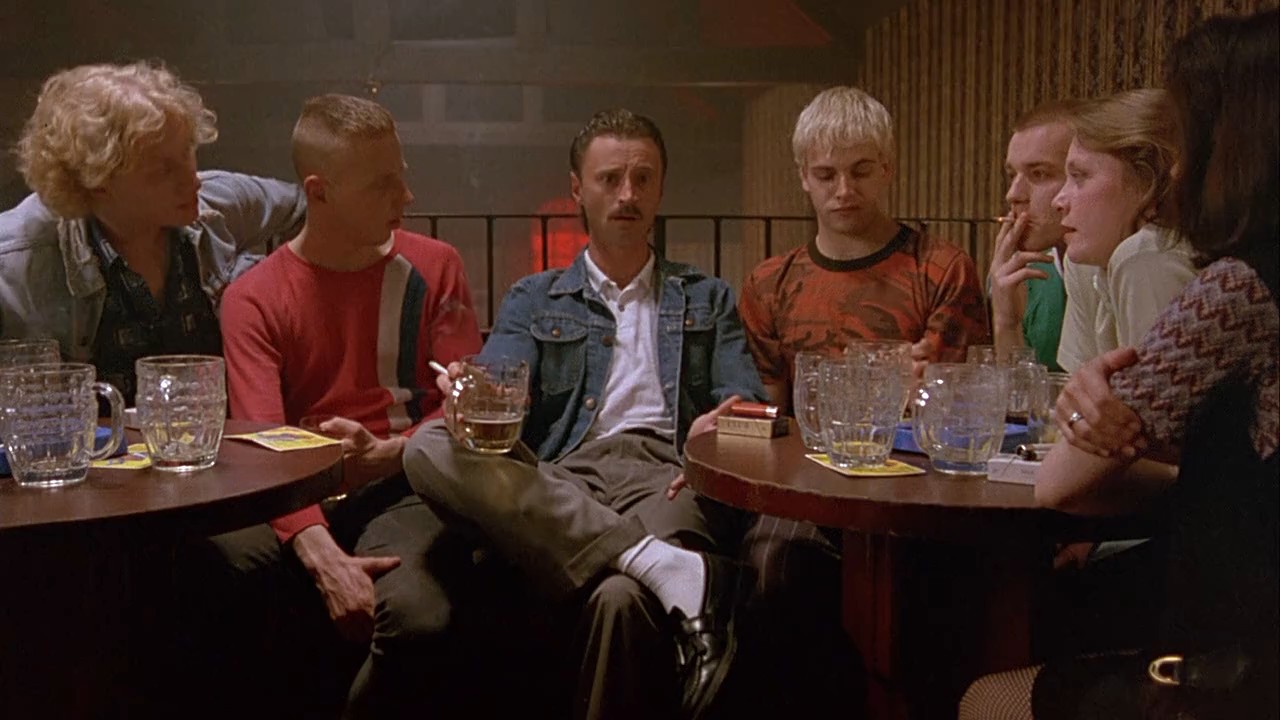
Danny Boyle’s 1996 adaptation of Irvine Welsh novel takes this list far from the ‘cosier’ community pub scenes it has previously explored. Following the lives of a small group of addicts in Edinburgh the film is set somewhat ambiguously at some point in the 80’s/early 90’s.
Gone are the natural fibres, open fires, folk songs and seemingly anyone over the age of 40 as bright synthetics, bright lights, over-crowded bars, stark decor and doubtless sticky floors set the mood of the urban pub. Trainspotting features several scenes/sequence at pubs, bars and night clubs but for this list it is the alcohol fuelled violent antics of Francis Begbie (Robert Carlyle) which take centre stage. Renton’s (Ewan McGregor) narration introduces us to Begbie, as the group sit bunched around a couple of tables on an upper level of a bustling pub.
Begbie tells a tall tale, takes a swig from his pint before casually throwing his empty glass over his shoulder and sending it hurtling over the balcony, the film freeze frames, we flashback to the truth of Begbie’s story before returning to the pub scene, the film unfreezes, the sound of smashing glass, a beat, a scream from below, Carlyle’s character slams a knife down on the table and hurries downstairs, pending confusion and panic as a young woman stands bleeding from her injuries. Within seconds the whole place erupts into violence as furniture and wild punches fly, much to Begbie’s delight, leaving Renton and friends at the table to observe the chaos below.
It could be said that this violence is just part of another on screen pub convention or even ritual, the pub brawl. Its depiction of an almost spontaneous combustion of random fighting is (like An American Werewolf in London) also comparable the kind of screen convention viewers may expect to see in a Western, one could argue it is a similar post-modern pop-culture reference, raw in its violence but also played for referentially comedic effect.
This pub scene, like the majority of the film was actually filmed in Glasgow at a venue called Crosslands, located on Queen Margaret Drive apparently it now contains an oil painting depicting this very scene.